About Research Domains

- JST HOME
- SM4I HOME
- Research Domains Top
- MI Top
- Subjects for each center of excellence
[Main Text]
About Research Domains
Development of Simulation Technique for Performance Assurance of Weld Joints
(D65)
Concept and Approach
Weld joints technique is a base manufacturing technique and it is essential to ensure the performance of weld joints in order to make the performance of structural materials demonstrate perfectly in the products, because the weld joints become a part of them.
It is necessary to predict the material change and the property change in weld joints in order to ensure the performance of weld joints, because rapid heating and cooling by welding could greatly change the microstructure of the weld joints and cause defects and deterioration of mechanical properties. However, the consistent simulation from heat source modeling to fitting performance evaluation has not been established internationally yet.
We aim to develop overall simulation techniques to predict the formation process of weld joints by arc and laser, the phenomena of occurrence of defect such as cracks after solidification process, the formation process of microstructure by rapid thermal cycle, and then finally to predict the performance of weld joints to be part of structure.
In order to achieve this goal, we have set up the following three individual subjects, and formed the center of excellence for comprehensively predicting the welding process, the weld microstructure and the weld joint performance.
- 1. Development of Prediction Technique of Weld Pool Formation with Heat Source Model
- 2. Development of Prediction Technique of Weld Properties Involving Solidification and Microstructural Change
- 3. Development of Prediction Technique of Fracture Performance of Weld Joints
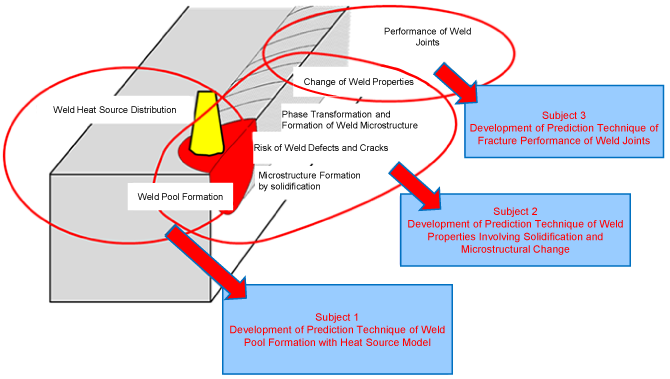
Unit Structure and Role
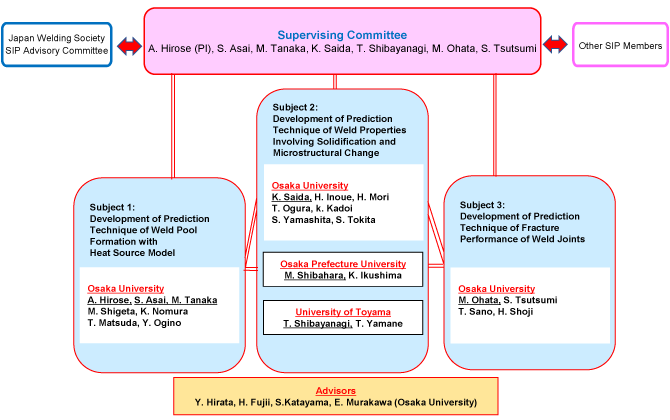
Research and Development
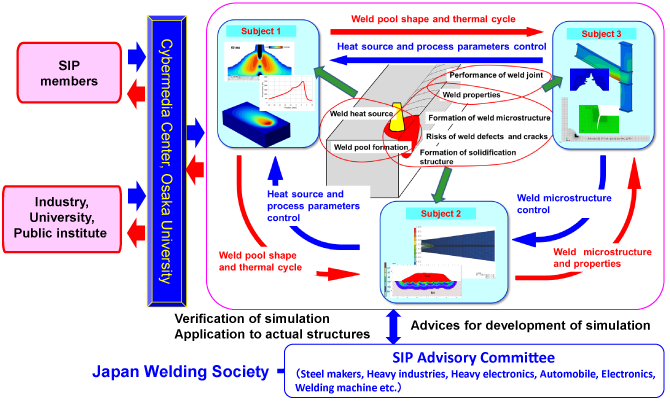
We have set up the following three individual subjects and formed the center of excellence for comprehensively predicting the welding process, the weld microstructure and the weld joint performance.
Subject 1: Development of Prediction Technique of Weld Pool Formation with Heat Source Model
We integrate the heat source model and the weld pool formation model, and develop a numerical simulation prediction technology for the weld pool formation with dynamic fluctuation in three-dimensional space.
In addition, we aim to develop innovative measurement technology “Laser Ultrasonic in-situ Weld Pool Shape Measurement System”, and to contribute to the application of in-situ inspection technology, the accuracy improvement and expansion of the applicable range for the simulation technique.
Subject 2: Development of Prediction Technique of Weld Properties Involving Solidification and Microstructural Change
We are developing prediction of microstructural formation for melting and solidification specific to the welding process and subsequent cooling process, and prediction technique of weld properties by them as well as prediction technique for occurrence of welding defect (hot cracking).
Subject 3: Development of Prediction Technique of Fracture Performance of Weld Joints
We are developing a simulation technique to predict the performance of multi-layer weld joints with geometrical discontinuity and material heterogeneity based on the mechanical property of the welded components including the base material.
We integrate simulation technique established for each individual subject. In the first stage, we conduct the prediction of the structure at each part of weld from weld pool shape and thermal cycle prediction, and then try to complete the forward direction simulation to predict joint performance based on that. In the second stage, we aim to present structure control policy to secure weld performance and the policy of heat source and process control by reverse direction simulation, which is our final goal.
We have also set up the SIP welding hub subcommittee at Welding Society in order to promote the practical application of the developed simulation technique, and established a structure to receive advice for our project from participating companies in various fields of manufacturing who require welding technology.
The Center of Excellence for Innovative Measurement and Analysis
Development of Innovative Measurement and Analysis for Structural Materials to acquire unutilized information
(D66)
Concept and Approach
The method to solve the problem by relying on the conventional experiences and intuition cannot respond quickly to the demand for energy saving which is always required for structural materials. It is necessary to understand material properties and transform into material development based on scientific prediction in order to continually create innovation, regarding material performance prediction, life expectancy and manufacturing process optimization. Therefore, the innovative measurement technique of performance exceeding the existing measurement technique is required.
At the Tsukuba Innovation Arena (TIA), we apply the innovative measurement instruments and technologies used in the nanotechnology field and others to structural materials development from a new perspective.
We acquire unutilized information which cannot be handled by the conventional measurement technique and has not been utilized in material development, and we contribute to the acceleration of materials development time by a factor of ten.
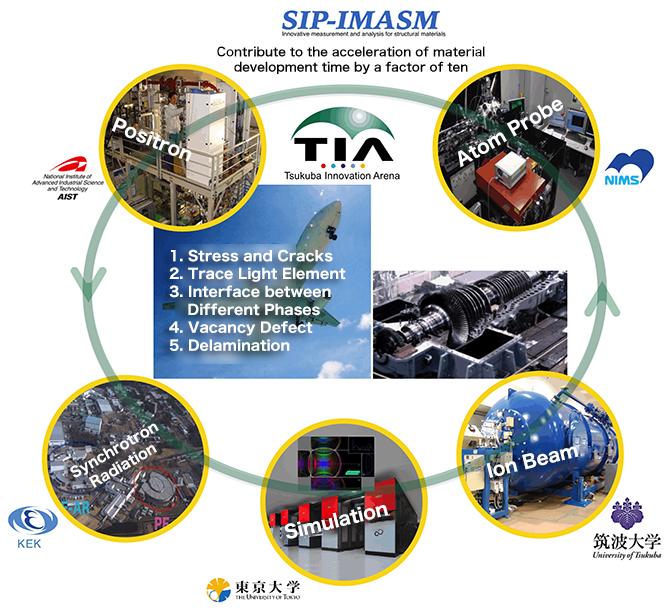
Unit Structure and Role
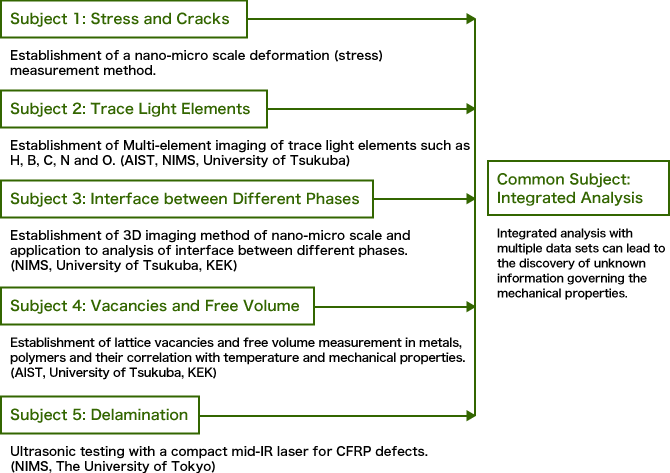
Research and Development

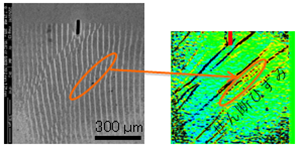
Shear strain during mechanical test was visualized by sampling moiré method. It can detect precursor state before crack occurrence. It is possible to realize displacement measurement precision one digit higher than ordinary image processing.
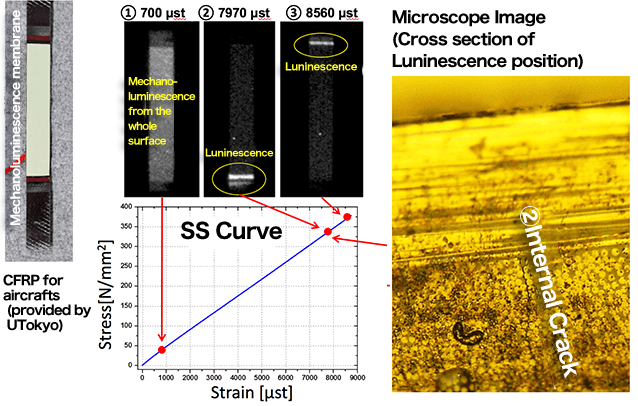
We have succeeded in nondestructively imaging cracks generated inside the CFRP laminated board for aircraft by mechanoluminescence.


3D atom map of stainless steel. We can find nano-segregation of Si and nano-precipitation of silicide.
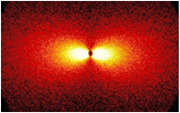
Small angle X-ray scattering image obtained from CFRP. The anisotropic microvoids inside the carbon fiber can be seen.

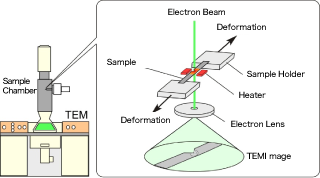
We have realized atomic scale TEM observation in the state of external force application under the actual temperature environment where heat resistant composites are used.
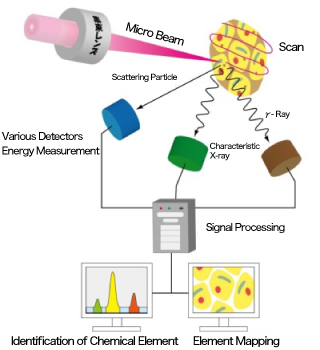
It is possible to detect elemental mapping and hydrogen by nuclear reaction using micro ion beam from ion accelerator.

Inter-University Research Institute Corporation
High Energy Accelerator Research Organization (KEK)
[GOAL] We are aiming to measure the residual stress and cracks which are major controlling factor of lifetime, fracture and strength of structural materials, and to lead it to control of process from void nucleation to crack initiation/ progress and fracture. For that purpose, we will mainly utilize synchrotron radiation (high brightness, high quality x-rays) and observe the same field of view of structure/crack and chemical state at multi scale, and we will lead it to the elucidation of controlling factor of macro properties.
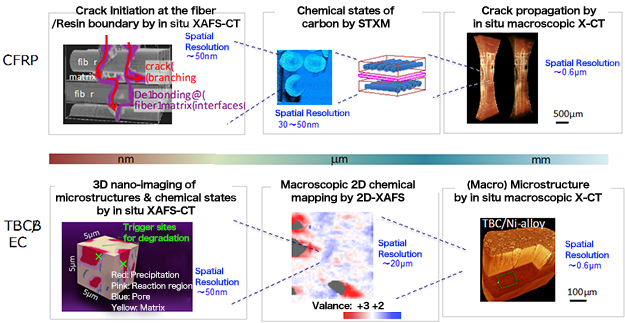
[A particularly unique approach:
XAFS-CT (X-ray Absorption Fine Structure – Computed Tomography)]
This method can be used to observe both structure/crack and chemical state by 3D, high spatial resolution (50 nm), using synchrotron radiation. It was newly established in Synchrotron Radiation Facility of High Energy Laboratory (PF-AR NW2A) in 2017.

(a) CT imaging with variable X-ray energy (b) Obtain 3D imaging (c) Clarify reaction origin and mechanism of development from the observation of temporal change.

Find out more
https://sip-sm4i.kek.jp/index.html

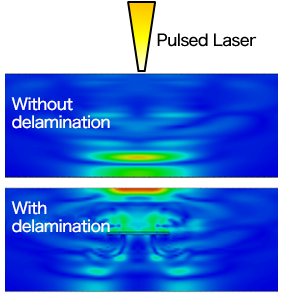
We perform laser ultrasound propagation simulations in CFRP laminate to develop the practical system. Figure shows the ultrasound reflection and scattering near the delamination region in CFRP. Carrying out computer simulation under the variety of initial condition such as material properties, measurement condition and defect geometry, we are aiming for detection and measurement of micro size delamination and vacancies, which couldn’t be measured with conventional equipment.
The Center of Excellence at Kyushu University
Technology construction for overcoming unresolved issues in structural materials through "Interface"
(D67)
Concept and Approach
We have specifically five research subjects which are related to macrostructure formation of structural materials through solidification, phase transformation, deformation, recrystallization and grain growth as well as performance control factors such as fatigue, creep, hydrogen embrittlement and fracture. Not only do we solve the individual subject as an example, we also provide basic foundation tools and generic data that can be widely applied to various structural materials and can also accelerate material development. Furthermore, we are aiming to contribute to the design of innovative materials, material property, prediction of material performance and significant shortening of development period by constructing material prediction theory.
From fiscal 2017, we have narrowed down the target material in the four subjects to forging titanium alloy, and are promoting research and development with a focus on D domain (MI development) and B domain.
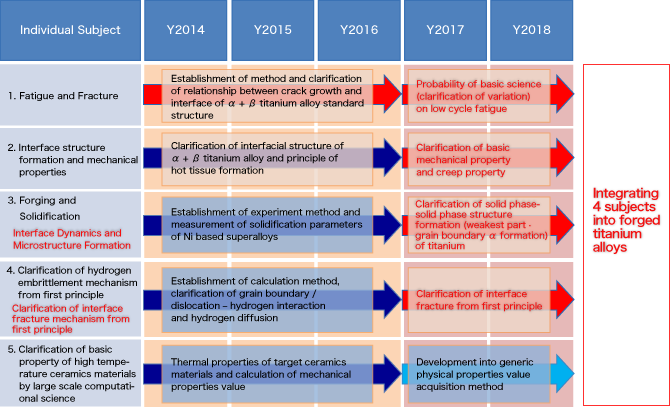
List of R&D Projects and Units
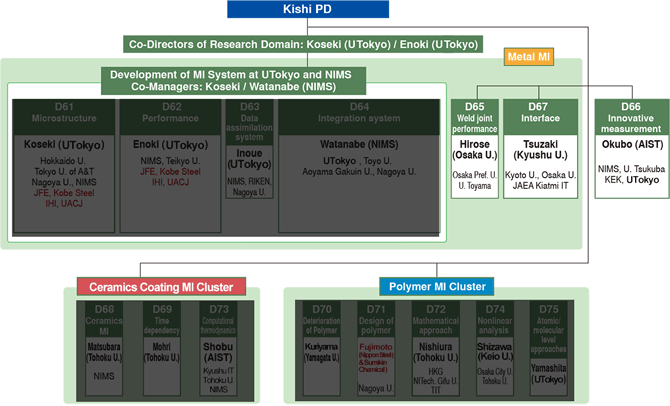
| Category | No. | R&D Project | Research Unit | Unit Leader |
|---|---|---|---|---|
| Metal MI | D61 | Materials Integration | Development of Microstructure Prediction System | ◎☆Toshihiko Koseki (UTokyo) |
| D62 | Development of Performance Prediction System | Manabu Enoki (UTokyo) | ||
| D63 | Development of a System for Data Assimilation and Machine Learning | Junya Inoue (UTokyo) | ||
| D64 | Development of Materials Integration System | ☆Makoto Watanabe (NIMS) | ||
| D65 | Development of Simulation Technique for Performance Assurance of Weld Joints | ☆Akio Hirose(Osaka U.) | ||
| D67 | Fundamental Research Focusing on Interface for overcoming Unsolved issues in Structural Materials | ☆Kaneaki Tsuzaki (Kyushu U.) | ||
| Innovative Measurement | D66 | Innovative Measurement and Analysis for Structural Materials | ☆Masataka Ohkubo (AIST) | |
| Ceramics Coating MI | D68 | Development of Simulation for Mass Transfer at High Temperature and Time Dependent Behavior of Microstructure | Hideaki Matsubara (Tohoku U.) | |
| D69 | Development of Computational Tools to Predict Time Dependent Phenomena in Structural Materials | Tetsuo Mohri (Tohoku U.) | ||
| D73 | Establishment of Domestic Technology Base for Computational Thermodynamics for Development of Advanced Structural Materials | Kazuhisa Shobu (AIST) | ||
| Engineering Polymers MI | D70 | Development of Prediction Tools for Long-term Properties of High Performance Engineering Plastics | Takashi Kuriyama (Yamagata U.) | |
| D71 | Development of Practical Optimal Design and Comprehensive Evaluation Support Tool for Advanced Structural Polymer Materials | Shin-etsu Fujimoto (Nippon Steel & Sumikin Chemical) | ||
| D72 | Mathematical Approach Toward Materials Integration and its Applications | Yasumasa Nishiura (Tohoku U.) | ||
| D74 | Performance Prediction for Polymers by Nonlinear Analysis | Kazuyuki Shizawa (Keio U.) | ||
| D75 | Atomic / Molecular-level Approaches for Designing Novel Polymeric Materials | Takefumi Yamashita (UTokyo) | ||
◎:Co-Director of Research Domain ☆:Co-Manager
